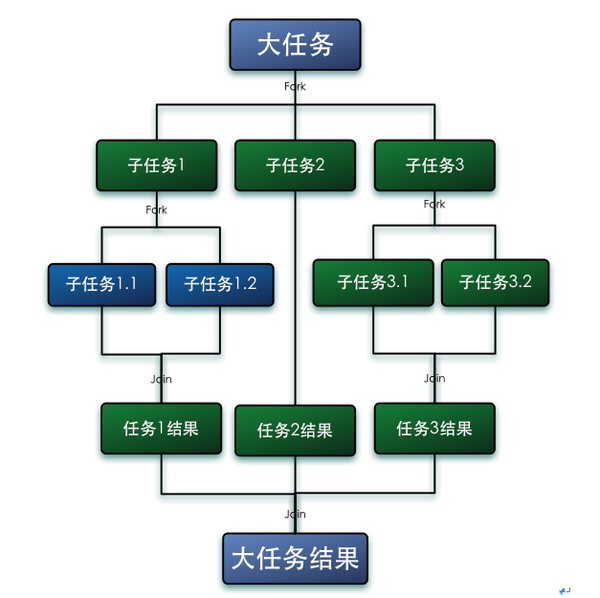来源:http://wankunde.iteye.com/blog/1521042
ForkJoinPool 是 Java SE 7 新功能“分叉/结合框架”的核心类,现在可能乏人问津,但我觉得它迟早会成为主流。分叉/结合框架是一个比较特殊的线程池框架,专用于需要将一个任务不断分解成子任务(分叉),再不断进行汇总得到最终结果(结合)的计算过程。比起传统的线程池类ThreadPoolExecutor,ForkJoinPool 实现了工作窃取算法,使得空闲线程能够主动分担从别的线程分解出来的子任务,从而让所有的线程都尽可能处于饱满的工作状态,提高执行效率。

ForkJoinPool 提供了三类方法来调度子任务:
execute 系列异步执行指定的任务。invoke 和 invokeAll执行指定的任务,等待完成,返回结果。submit 系列异步执行指定的任务并立即返回一个 Future 对象。子任务由 ForkJoinTask 的实例来代表。它是一个抽象类,JDK 为我们提供了两个实现:RecursiveTask 和 RecursiveAction,分别用于需要和不需要返回计算结果的子任务。ForkJoinTask 提供了三个静态的 invokeAll 方法来调度子任务,注意只能在 ForkJoinPool 执行计算的过程中调用它们。ForkJoinPool 和 ForkJoinTask 还提供了很多让人眼花缭乱的公共方法,其实它们大多数都是其内部实现去调用的,对于应用开发人员来说意义不大。下面以统计 D 盘文件个数为例。这实际上是对一个文件树的遍历,我们需要递归地统计每个目录下的文件数量,最后汇总,非常适合用分叉/结合框架来处理:
// 处理单个目录的任务
public class CountingTask extends RecursiveTask<Integer> {
private Path dir;
public CountingTask(Path dir) {
this.dir = dir;
}
@Override
protected Integer compute() {
int count = 0;
List<CountingTask> subTasks = new ArrayList<>();
// 读取目录 dir 的子路径。
try (DirectoryStream<Path> ds = Files.newDirectoryStream(dir)) {
for (Path subPath : ds) {
if (Files.isDirectory(subPath, LinkOption.NOFOLLOW_LINKS)) {
// 对每个子目录都新建一个子任务。
subTasks.add(new CountingTask(subPath));
} else {
// 遇到文件,则计数器增加 1。
count++;
}
}
if (!subTasks.isEmpty()) {
// 在当前的 ForkJoinPool 上调度所有的子任务。
for (CountingTask subTask : invokeAll(subTasks)) {
count += subTask.join();
}
}
} catch (IOException ex) {
return 0;
}
return count;
}
}
// 用一个 ForkJoinPool 实例调度“总任务”,然后敬请期待结果……
Integer count = new ForkJoinPool().invoke(new CountingTask(Paths.get("D:/")));
在我的笔记本上,经多次运行这段代码,耗费的时间稳定在 600 豪秒左右。普通线程池(Executors.newCachedThreadPool())耗时 1100 毫秒左右,足见工作窃取的优势。
结束本文前,我们来围观一个最神奇的结果:单线程算法(使用 Files.walkFileTree(...))比这两个都快,平均耗时 550 毫秒!这警告我们并非引入多线程就能优化性能,并须要先经过多次测试才能下结论。
实际测试
package com.forkjoin.countdir;
import java.io.File;
import java.util.ArrayList;
import java.util.List;
import java.util.concurrent.ForkJoinPool;
import java.util.concurrent.RecursiveTask;
import com.util.DateTime;
public class CountTaskRecursive extends RecursiveTask {
int sum =0;
File file ;
public CountTaskRecursive(File file) {
this.file = file;
}
@Override
protected Integer compute() {
Integer csum =0;
List<CountTaskRecursive> tasklist = new ArrayList<CountTaskRecursive>() ;
if(file.isDirectory())
{
for(File f:file.listFiles())
{
CountTaskRecursive t = new CountTaskRecursive(f);
tasklist.add(t);
}
}
else
csum ++;
if(!tasklist.isEmpty())
{
for(CountTaskRecursive t :invokeAll(tasklist))
csum += (Integer)t.join();
}
return csum;
}
public static void main(String[] args) {
DateTime dt = new DateTime() ;
System.out.println("系统日期:"+dt.getDate()) ;
System.out.println("中文日期:"+dt.getDateComplete()) ;
System.out.println("时间戳:"+dt.getTimeStamp()) ;
CountTaskRecursive task = new CountTaskRecursive(new File("F:\\私人资料"));
Integer sum = (Integer)new ForkJoinPool().invoke(task);
System.out.println(sum);
dt = new DateTime() ;
System.out.println("系统日期:"+dt.getDate()) ;
System.out.println("中文日期:"+dt.getDateComplete()) ;
System.out.println("时间戳:"+dt.getTimeStamp()) ;
}
}
package com.forkjoin.countdir;
import java.io.File;
import java.security.Timestamp;
import java.util.Calendar;
import com.util.DateTime;
public class CountTaskSingle {
static int sum = 0;
public void countDir(File file)
{
if(file.isDirectory())
{
for(File f:file.listFiles())
countDir(f);
}
else
sum++;
}
public static void main(String[] args) {
CountTaskSingle ins = new CountTaskSingle();
DateTime dt = new DateTime() ;
System.out.println("系统日期:"+dt.getDate()) ;
System.out.println("中文日期:"+dt.getDateComplete()) ;
System.out.println("时间戳:"+dt.getTimeStamp()) ;
ins.countDir(new File("F:\\私人资料"));
System.out.println(sum);
dt = new DateTime() ;
System.out.println("系统日期:"+dt.getDate()) ;
System.out.println("中文日期:"+dt.getDateComplete()) ;
System.out.println("时间戳:"+dt.getTimeStamp()) ;
}
}
package com.util;
import java.util.*; // 导入需要的工具包
public class DateTime { // 以后直接通过此类就可以取得日期时间
private Calendar calendar = null; // 声明一个Calendar对象,取得时间
public DateTime() { // 构造方法中直接实例化对象
this.calendar = new GregorianCalendar();
}
public String getDate() { // 得到的是一个日期:格式为:yyyy-MM-dd HH:mm:ss.SSS
// 考虑到程序要频繁修改字符串,所以使用StringBuffer提升性能
StringBuffer buf = new StringBuffer();
buf.append(calendar.get(Calendar.YEAR)).append("-"); // 增加年
buf.append(this.addZero(calendar.get(Calendar.MONTH) + 1, 2)).append("-"); // 增加月
buf.append(this.addZero(calendar.get(Calendar.DAY_OF_MONTH), 2)).append(" "); // 取得日
buf.append(this.addZero(calendar.get(Calendar.HOUR_OF_DAY), 2)).append(":"); // 取得时
buf.append(this.addZero(calendar.get(Calendar.MINUTE), 2)).append(":");
buf.append(this.addZero(calendar.get(Calendar.SECOND), 2)).append(".");
buf.append(this.addZero(calendar.get(Calendar.MILLISECOND), 3));
return buf.toString();
}
public String getDateComplete() { // 得到的是一个日期:格式为:yyyy年MM月dd日 HH时mm分ss秒SSS毫秒
// 考虑到程序要频繁修改字符串,所以使用StringBuffer提升性能
StringBuffer buf = new StringBuffer();
buf.append(calendar.get(Calendar.YEAR)).append("年"); // 增加年
buf.append(this.addZero(calendar.get(Calendar.MONTH) + 1, 2)).append("月"); // 增加月
buf.append(this.addZero(calendar.get(Calendar.DAY_OF_MONTH), 2)).append("日"); // 取得日
buf.append(this.addZero(calendar.get(Calendar.HOUR_OF_DAY), 2)).append("时"); // 取得时
buf.append(this.addZero(calendar.get(Calendar.MINUTE), 2)).append("分"); // 取得分
buf.append(this.addZero(calendar.get(Calendar.SECOND), 2)).append("秒"); // 取得秒
buf.append(this.addZero(calendar.get(Calendar.MILLISECOND), 3)).append("毫秒"); // 取得毫秒
return buf.toString();
}
public String getTimeStamp() { // 得到的是一个时间戳
// 考虑到程序要频繁修改字符串,所以使用StringBuffer提升性能
StringBuffer buf = new StringBuffer();
buf.append(calendar.get(Calendar.YEAR)); // 增加年
buf.append(this.addZero(calendar.get(Calendar.MONTH) + 1, 2)); // 增加月
buf.append(this.addZero(calendar.get(Calendar.DAY_OF_MONTH), 2)); // 取得日
buf.append(this.addZero(calendar.get(Calendar.HOUR_OF_DAY), 2)); // 取得时
buf.append(this.addZero(calendar.get(Calendar.MINUTE), 2)); // 取得分
buf.append(this.addZero(calendar.get(Calendar.SECOND), 2)); // 取得秒
buf.append(this.addZero(calendar.get(Calendar.MILLISECOND), 3)); // 取得毫秒
return buf.toString();
}
// 考虑到日期中存在前导0,所以在此处加上补零的方法
private String addZero(int num, int len) {
StringBuffer s = new StringBuffer();
s.append(num);
while (s.length() < len) { // 如果长度不足,则继续补0
s.insert(0, "0"); // 在第一个位置处补0
}
return s.toString();
}
};
执行结果:
单线程执行结果
系统日期:2012-05-09 23:59:07.468
中文日期:2012年05月09日23时59分07秒468毫秒
时间戳:20120509235907468
389578
系统日期:2012-05-09 23:59:56.421
中文日期:2012年05月09日23时59分56秒421毫秒
时间戳:20120509235956421
多线程执行结果
系统日期:2012-05-10 00:01:57.500
中文日期:2012年05月10日00时01分57秒500毫秒
时间戳:20120510000157500
389578
系统日期:2012-05-10 00:09:00.281
中文日期:2012年05月10日00时09分00秒281毫秒
时间戳:20120510000900281




